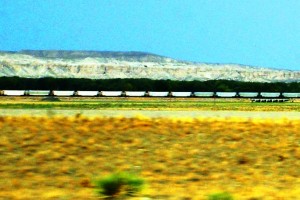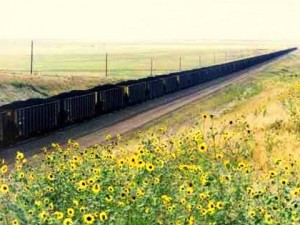» posted on Saturday, September 15th, 2012 by Linda Lou Burton
King of Coal
 Linda Burton posting from Cheyenne, Wyoming – Mile-long coal trains followed me into Cheyenne yesterday, a sight to see. I’m back to mountains now, the Laramies. Natures foothills were the dark green backdrop for the distant man-made slivers moving south across my westward view. Blue sky and silver trains; I stopped counting at twelve. The tracks merged closer to the freeway as I neared the city; they converged across the street from my hotel. Through the night I heard the muffled rumblings of the trains; from the breakfast room this morning I watched them roll. Where does this coal come from, I wanted to know, and where is it going? Wyoming coal.
Linda Burton posting from Cheyenne, Wyoming – Mile-long coal trains followed me into Cheyenne yesterday, a sight to see. I’m back to mountains now, the Laramies. Natures foothills were the dark green backdrop for the distant man-made slivers moving south across my westward view. Blue sky and silver trains; I stopped counting at twelve. The tracks merged closer to the freeway as I neared the city; they converged across the street from my hotel. Through the night I heard the muffled rumblings of the trains; from the breakfast room this morning I watched them roll. Where does this coal come from, I wanted to know, and where is it going? Wyoming coal.
There are 68,700,000,000 tons of coal in Wyoming. In the year 2009, Wyoming coal mines produced 432,481,322 tons of low sulfur coal, accounting for about 40% of the nation’s coal. Wyoming coal is used in 38 states to generate electricity. Coal underlies 54% of the state, covering 53,000 square miles. There are 10 coal fields; 4 are producing now with 22 mines. That’s a mind-boggling array of numbers; let’s reduce it to a simple fact: 
Wyoming is the #1 coal-producing state. You need a lot of trains for that.
The typical coal train, called a Unit Train, is 100 to 120 cars long – that’s about a mile of coal. Each hopper car holds 100 to 115 tons of coal. Big surface mines may load two or three Unit Trains of coal a day. One Unit Train can keep a city of 3,000 households in electricity for a year. About 85 trains leave Wyoming every day.
Enough with the numbers, let’s look at a little history. Ironically, coal was first mined as fuel for the trains. Specifically, the coal-fired steam engines of the Union Pacific Transcontinental Railroad. Some of the first mines were at Carbon, west of Medicine Bow, and at Rock Springs. The underground mines were ventilated by the use of traps at the entrances, facing the direction from which wind was blowing, permitting fresh air to enter the mine. The town of Carbon burned in 1890; the railroad was relocated in 1899; by 1902 Carbon, and its mines, were abandoned.
 As diesel engines came along most coal mines closed. But that began to change with the development of huge draglines, shovels, and haul trucks, and the demand for cheap coal for electricity-generating plants. Today’s Wyoming coal comes from immense open-pit mines. Those 10 coal fields are scattered around the state – Big Horn, Black Hills, Goshen Hole, Green River, Hams Fork, Hanna, Jackson Hole, Powder River, Rock Creek, and Wind River are their names; but the Powder River Basin in the northeast corner of the state is the headline maker.
As diesel engines came along most coal mines closed. But that began to change with the development of huge draglines, shovels, and haul trucks, and the demand for cheap coal for electricity-generating plants. Today’s Wyoming coal comes from immense open-pit mines. Those 10 coal fields are scattered around the state – Big Horn, Black Hills, Goshen Hole, Green River, Hams Fork, Hanna, Jackson Hole, Powder River, Rock Creek, and Wind River are their names; but the Powder River Basin in the northeast corner of the state is the headline maker.
 It is the single largest source of coal mined in the United States, and contains one of the largest deposits of coal in the world. Because of the Powder River Basin, Wyoming has been the top coal-producing state since 1988. Coal production’s center of gravity in the United States has moved; from central Appalachia to the Powder River Basin.
It is the single largest source of coal mined in the United States, and contains one of the largest deposits of coal in the world. Because of the Powder River Basin, Wyoming has been the top coal-producing state since 1988. Coal production’s center of gravity in the United States has moved; from central Appalachia to the Powder River Basin.
The Black Thunder Coal Mine in the Basin is one of the most productive coal mines in the United States. Owned by Arch Coal, it operates six draglines, 22 shovels, and 148 haul trucks and sold 104.9 million tons of coal in 2011. It claims to be the largest single coal-mining complex in the world and the first coal mine in the world to ship 1 billion tons.
Now I know where all that coal I saw is coming from, and where it’s going – almost everywhere. The controversy surrounding the mining of coal will continue in the news; it’s an emotion-stirred debate. On the one hand, without question, we need energy, and we need jobs. On the other, the call is out for renewable, clean energy, and protection of our environment for generations to come.
Meanwhile, whatever the answer, Wyoming has the coal.
About Black Thunder Mine, Gillette, Wyoming http://www.archcoal.com/aboutus/blackthunder.aspx
